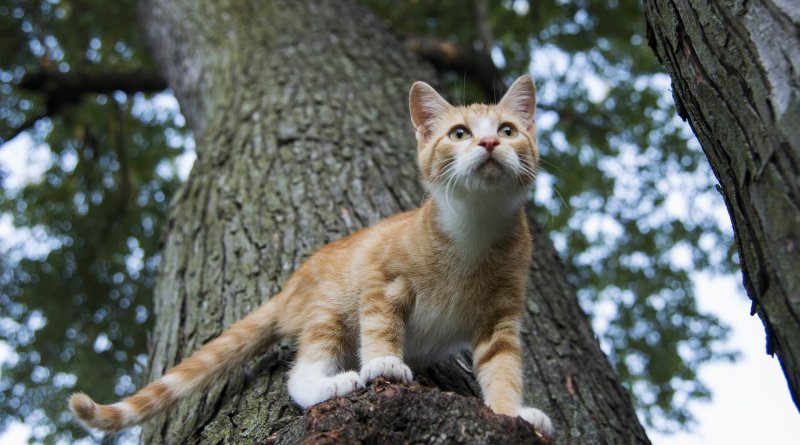How to Keep Your Outdoor Cats Safe and Healthy
Last Updated on
In this article, you’ll learn about tools and techniques to keep outdoor cats safe and healthy. These tips are geared towards cats who live outdoors full-time—ferals, barn cats, and former strays or ferals who can’t stand to stay inside.
There’s nothing you can do to make the outdoors completely safe for your cat, but with the right steps, you can minimize those risks and ensure a longer, safer life outdoors.
Spay or neuter your cat.
Having your pet spayed or neutered decreases their drive to go find a potential mate—a drive that gets outdoor cats into a lot of trouble.
Intact cats are more likely to wander away from their home and be attacked by wild animals, dogs, or other cats. Almost all cat fight-related injuries that come into a veterinary office are intact male cats. Though they don’t get into as many fights, unspayed female cats are extremely likely to get pregnant living outside. An unspayed female cat can have up to 30-40 kittens a year. Spaying your cat eliminates the potential that your cat will develop uterine or ovarian cancer and reduces her chances of developing breast cancer later in life.
Vaccinate your cat.
To keep your cat healthy, make sure they are up to date on all vaccines, especially their rabies vaccine. The rabies virus can be carried by wild animals and transferred to your cat by a bite or scratch. Outdoor cats can also transmit feline leukemia and feline aids. These diseases are transferred from infected cats by biting each other.
Provide a safe place for your cat.
It is a good idea to have a cat house for outdoor cats to retreat to during severe weather. This will be a place for them to get out of the rainy or cold weather or hide from bigger wild predators and unfriendly dogs. This space should be far away from busy roads, driveways, and other dangers.
You don’t need to buy a special cat shelter. A shelter made from a Rubbermaid tote is the gold standard among feral cat carers. It’s easy to make and has everything a cat needs to stay comfortable no matter the weather—it’s waterproof, warm, easy to enter and escape, and simple for you to disassemble and clean.
Here’s a video showing you how to make a shelter from a large Rubbermaid box:
Outfit your outdoor cat with the right collar and identification.
All pets who spend time alone outside should have a collar with a pet ID tag on it. Your name and number should be on the tag so if your cat does get injured or lost, the person who finds them can get them back to where they’re from.
Many sick and injured cats will find the closest person to them to seek help and they may not always be familiar with your cat. Adult cats cover some impressive distances when they go on the prowl. The person who finds your cat won’t necessarily be a close neighbor and that identification is essential. In case your cat’s collar breaks off during the journey, consider having them microchipped. This will also allow your cat to be identified and returned to you. All veterinary office and shelters have a microchip scanner and can return your pet to you if they end up lost and found by someone else.
Many outdoor cats climb trees or fences for exploring and hunting purposes. It’s important to put a breakaway collar on them so if they do get caught on something their collar will break free and they will not strangle themselves.
Don’t invite trouble (coyotes).
In the United States, the coyote is the domesticated cat’s deadliest natural predator. Aside from the state of Hawaii, coyotes are everywhere in the States, including suburban or even urban environments.
There’s nothing you can do to guarantee that a coyote won’t catch your outdoor cat, but you can do your best to make your yard less inviting.
Coyotes will be attracted to a yard full of tasty and smelly treats, so bring your cats’ food inside as soon as you can, cover your trash or keep it inside, and don’t let fruit rot around any fruit trees. On the flip side, you may be able to deter coyotes using a different kind of smell—wolf urine. Wolf urine’s threatening smell may keep some coyotes away but like anything else, it’s not a guaranteed solution.
Know where your cats hang out most and remove any coyote cover. This could include shrubs, stumps, bushes, tall grass, and any other areas where a coyote could hide and stalk their prey.
And if you do see a coyote in your yard, scare him away! Yell, wave, and throw things. You don’t want a coyote to become comfortable in your territory.
Again, there’s no simple trick that will make the outdoors a safe place for cats.
Unless necessary, the inside of your house is always the best place for your cat to stay—it’s warm and protected. No cars zooming down the road. No coyotes looking for a midnight snack. Yet like all things overly safe, the indoors can be a bit dull, leaving cats overweight and understimulated.
To give your cat the best of both worlds, invest in a good cat harness and leash, then start taking your cat out on supervised expeditions into the world outdoors. Your cat can do all the bug-hunting they want and you’ll have the peace of mind that comes with knowing where your cat’s going to sleep tonight.
About the Author:
Chris Carpenter is the author of the book, Vet Set Go!, which aims to help teach tweens and teens how to become a vet. As a licensed vet himself, Dr. Carpenter hopes his knowledge and passion for animals can help aspiring vets succeed in the industry.








